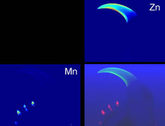Spiders don’t have flashy metal fangs, but they do rely on metal deposits to make their fangs extra strong and fracture resistant. Scorpions, crabs, worms and other creatures also have metal atoms in their claws, jaws and fangs. These deposits are an evolutionary feat of engineering; they make the structures significantly stronger and longer lasting. Rather than occurring in organized clusters of atoms—a shiny strip of tin foil is one example—they are single atoms held in place by non-metals. This is part of the reason that no one discovered these deposits until about 30 years ago: it is difficult to detect a single atom unless you are specifically looking for it. Moreover, the metals—mainly iron, copper, manganese and zinc—are present only in very small parts of the animal. This may include the very tips of scorpion or crab claws, the tiny fangs of spiders, or the jagged teeth on the mandibles of ants. The structures are small but undergo proportionally large stresses as they come into contact with the environment.
Robert M. S. Schofield of the University of Oregon, Michael H. Nesson of Oregon State University and Robert A. Scott of the University of Georgia are surveying as many creepy-crawlies as possible with a microprobe at Stanford Synchrotron Radiation Laboratory, hoping to shed light on the development of their unique structures and find common ancestors of these highly varied creatures. They detect the deposits with high-energy particle techniques, though not necessarily synchrotron radiation. Proton Induced X-Ray Emission (PIXE) and Scanning Transmission Ion Microscopy can determine the location and identity of individual elements on the scale of a few microns. X-ray synchrotron radiation, like that at SSRL, reveals the chemical environment, including the presence of individual atoms, their ionization state, and a hint at the metal and non-metal molecular structure. The next step is finding a way to look at those molecular structures directly.
Researchers would like to understand how these strong structures are built, and how individual metal atoms can change their properties. Fracture-resistant materials are usually soft and will bend or deform under pressure. But the structures in these organisms are hard as well as fracture resistant. “I don’t think that these materials are record holders in any particular category—for example, diamonds will certainly be harder. It is the mix of properties that is important,” Schofield says. “It may be that mimicking these materials will lead to man-made materials with an optimum balance of properties for certain small-scale tasks.”
The metals accumulate after molting, as the animals grow into adulthood. Researchers monitored the percentage of metal deposits at different times during development and observed the channels through which the metals migrate into appendages. They found that different metals settle in different areas: zinc is found in the tips of spider fangs while manganese is found in the trunk. Often, metal atoms in the newly hardened structures are also paired with specific non-metals: zinc with chlorine, and manganese with calcium. In the image above, the upper right frame shows X-ray detection of zinc; the lower left shows X-ray detection of manganese. The lower right frame combines the images: zinc is green and manganese is red.
Now that researchers know to look for them, these deposits are surfacing in a wide variety of species. Including the current survey, metal atoms have been found in 136 species of insects, 30 species of arachnids, 12 species of polychaete worms and four species of centipedes. Even so, there are still thousands of species to examine. Ultimately, researchers hope that understanding this biological pattern found in so many current species will guide the search for a common ancestor. Schofield explains that the appearance of new biomaterials has played a central role in evolution, and these metal atom structures should be no different. Biomaterials can open the door for organisms to develop drastically new characteristics, and even lead to extinction or evolution of new species.







